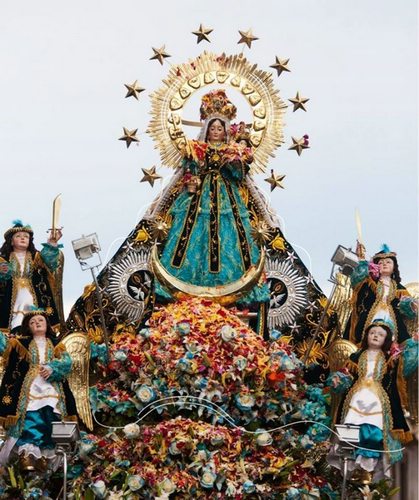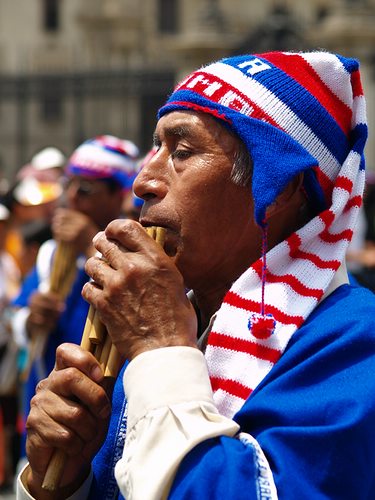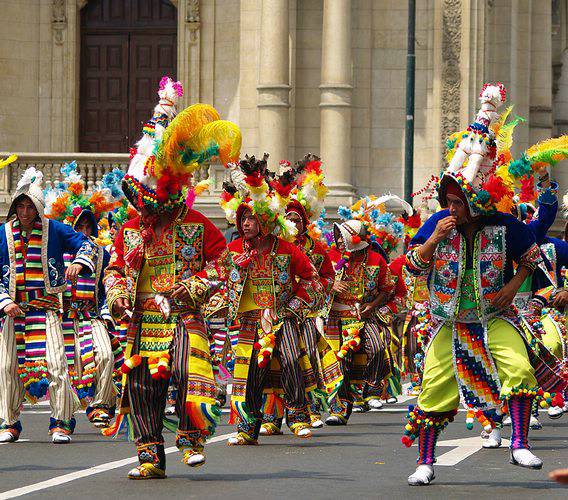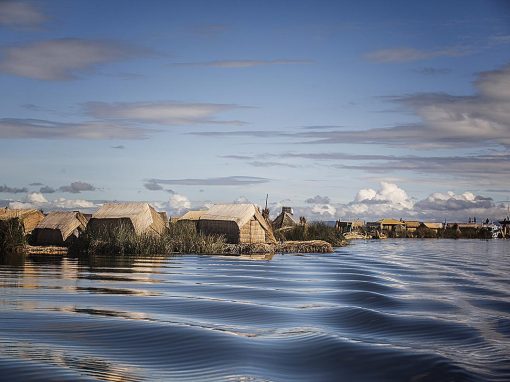Peru is famous for its many folkloric customs and religious festivals. But of all the celebrations taking place in the country, one stands out because of its wonderful ambiance, beautifully clothed dancers, and vibrant colors: the celebration of the Virgin of Candlemas, or “la Fiesta de la Virgen de la Candelaria.”
The festival takes place from February 2nd until the 18th in Puno, a port city serving as a gateway to Lake Titicaca, the world’s highest navigable lake. During the festival, Puno’s streets are dressed up in a festive mood, popular artists spread an uplifting spirit, and homage is paid to the patron saint of the city: the Virgin of Candelaria, also known as La Morenita.
Celebrating the Virgin of Candelaria
Who is the Virgin of Candelaria?
Celebrating the festival in Puno
Plan your own colorful adventure to Puno now!
Who is the Virgin of Candelaria?
The Virgin of Candlemas, known as La Virgen de la Candelaria in Spanish, is one of various representations of the famed Virgin Mary. The Catholic feast day is celebrated on February 2nd to honor the purification of the Virgin Mary forty days after the birth of Jesus. Historically, the Virgin de la Candelaria has been called La Morenita, which comes from the original sculpture located in Tenerife of the Canary Islands, in the Basilica Candelaria, which depicts the Virgen as a dark-skinned woman wearing a gold crown and a scepter. Many countries, including the Philippines, Cuba, Bolivia, and Peru celebrate the Virgin of Candlemas, and churches and statues have been dedicated in her honor. In Peruvian folklore, the Virgin de la Candelaria is light-skinned, and her statue has a special place in the church.
 The Virgin of Candlemas statue in Puno
The Virgin of Candlemas statue in Puno
Photo by Nella Barbieri-Myles
Legend states that during the 17th century in the viceroyalty period of Peru, rebel forces of indigenous Aymara people hailing from present-day La Paz layed siege on the city of Puno which was occupied by some 12,000 Spanish troops. After suffering major causalities during the siege of the village, the Spanish were significantly outnumbered and had little chance for victory. Out of desperation, the people of Puno decided to take the statue of the Virgin of Candelaria from the San Juan Church in a venerated procession through the streets of the village.
All through the night, they prayed to the Virgin to protect them from their invaders. When morning came, legend dictates that the Spanish were aided by the Virgin’s powers. It is said that their swords began to glow like fire and the hands of the statue of the Virgin of Candlemas became flames. Such a demonstration of divine intervention caused the rebel forces to flee the village and end the siege.
Celebrating the festival in Puno
Attending the festival for the Virgin de la Candelaria in Puno is a once in a lifetime experience. While the festival is largely worship-based, it also represents the pre-Columbian mining culture of Puno and the many pre-Columbian rituals that were practiced in the planting and harvest seasons of the area.
The festival starts on February 2nd with a pilgrimage at the break of dawn. Participants (including overseers, musicians, and invitees) trek to a hill where the homage to the Virgin of Candlemas is initiated. The festival overseers and musicians then descend from the hill with fireworks and songs. The group will continue singing and displaying fireworks until the San Juan Bautista Church (also known as the sanctuary where the Virgin of Candelaria dwells) is reached.
 During la Fiesta de la Virgen de la Candelaria, it is customary to play music using traditional Peruvian instruments, such as the wooden flute.
During la Fiesta de la Virgen de la Candelaria, it is customary to play music using traditional Peruvian instruments, such as the wooden flute.
Photo by Chimi Fotos/Flickr
Once the pilgrimage arrives at the church on this first day of the festival, morning mass begins. By the time the afternoon reaches, city limit farmers enter Puno on horseback, accompanied by the Andean priests more commonly known as “Yachiris.” These priests present prayers and offerings to the Lady of Candelaria.
A folkloric dance competition is also always held on the opening day of the festivities. For this competition, people dress up and head to the city’s stadium. More than 70 dance troupes (with up to 100 members in each) perform their folkloric dances from the varying religions. The main goal of the dancing is to please the Virgin of Candlemas. A winner is chosen by the end, and this group is able to claim that year’s title (and bragging rights!).
 The streets of Puno are filled with energy during this two-week festival.
The streets of Puno are filled with energy during this two-week festival.
Photo by Chimi Fotos/Flickr
Once the dancing competition is finished, the dancers and musicians leave the stadium and disperse in the city. The streets then become vibrant and alive with the sound of music. During the rest of the festival, dancers parade through the streets for days on end with a procession of brass bands. Puneños place a great deal of importance on the festival, and spend all year preparing for it. People come from far and wide to be a part of this special occasion.
 Colorful male dancers on the streets of Puno at the festival of the Lady of Candlemas
Colorful male dancers on the streets of Puno at the festival of the Lady of Candlemas
Photo by Chimi Fotos/Flickr
Various different types of dances can be seen during the festival, from traditional dances, to more modern ones. The “Diablada” – a dance ritual – is performed during the next 7 days. This dance is essential to the festival as it was created when a group of men trapped in a mine were given mercy by the Lady of Candelaria. When performing the Diablada, participants dress up in demon masks and as the God of the mines “Jacancho.” The dance concludes once dancers place flowers on the graves of the miners.
 Dancers performing the Diablada
Dancers performing the Diablada
Photo via Wikemedia Commons
The dancing, music, and bright colors of the Festival of the Virgin of Candelaria are sure to lift your spirits.
One thing to keep in mind is that a great deal of alcohol is consumed at this festival! Be sure to keep your belongings close to you at all times. Also keep in mind that the temperatures can be quite cold with the chance of light rain. It is recommended to bring a rain poncho or umbrella.
Plan your own colorful adventure to Puno now!
Peru for Less specializes in fully customizable Peru tours. Let us take you to Lake Titicaca to explore tradition and culture.

Hendrika is Belgian but she considers herself a citizen of the world as she has lived in many different countries before moving to Peru. She fell in love with South America after her first visit to the continent in Bolivia, and has since then spent a lot of time traveling in the area. She especially enjoys Peru for its diversity, delicious food, and rich history.







